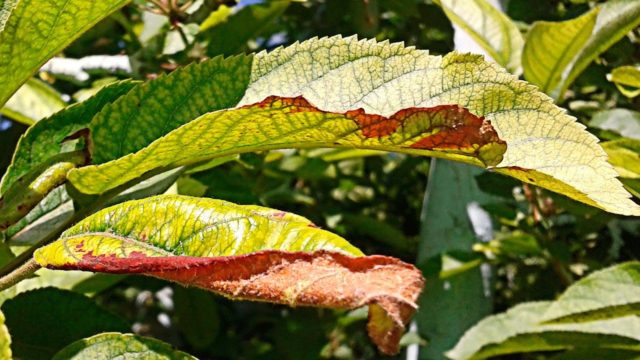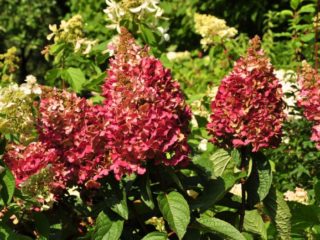Content
Hydrangea Magic Vesuvio is a rather unpretentious variety of Dutch origin. It blooms well in the middle lane and in the south of the country, but the plant can be grown in more northern regions if you provide it with a reliable shelter. The bush does not need special care.
Description of hydrangea Magical Vesuvio
Hydrangea Magical Vesuvio is a variety with abundant flowering and compact bush size. The height of the plant can reach 100-130 cm, while the diameter of the shrub is on average 100-150 cm.
The flowers are large, collected in dense, tall pyramidal inflorescences. At the very beginning of budding, their petals are colored white and light pink. Towards the end of flowering, they are filled with a rich pink tint with an admixture of red.
Hydrangea shoots are red-brown in color. By their structure, they are quite tough, so there is no need to tie up a bush. The leaves of the Magic Vesuvio variety are egg-shaped. The color of the leaf plate is dark green.
The flowering period lasts from late June to late August or early September.

In the Urals, the variety can bloom twice - in July and in the second half of August.
Hydrangea Magic Vesuvio in landscape design
In landscape design, the Magical Vesuvio hydrangea is used both in single plantings and for creating group compositions. The variety is perfect for decorating small gardens and narrow flower beds, as the plant is quite compact. Also from hydrangea Magical Vesuvio spectacular borders are obtained.

It is best to grow a shrub in a standard form
Winter hardiness of hydrangea Magic Vesuvio
Winter hardiness of the Magic Vesuvio variety is average - the plant can withstand temperatures around - 25-28 ° C, so it is recommended to cover plantings for the winter, especially in the northern regions. In the south of the country, adult bushes do not need to be insulated.
Planting and caring for hydrangea Magic Vesuvio
The optimal time for planting the Magic Vesuvio variety in open ground is early spring or early September. In the northern regions of the country, seedlings are transplanted to a permanent place exclusively in the spring, so that they have enough time for rooting. During autumn planting, freezing of the root system is possible with the onset of cold weather.
In the hot season, plantings are regularly watered, although in general the culture is drought-resistant. Further care of the panicle hydrangea consists only in periodic feeding. Sometimes the bush is thinned out, removing dry and damaged shoots.
Selection and preparation of the landing site
The hydrangea of the Magical Vesuvio variety is planted in places that are as protected from the wind as possible. It is better to choose medium illumination, but you can place the flower bed in the sun. In this case, during a period of extreme heat, the plant is artificially shaded.
The hydrangea Magical Vesuvio does not have any special requirements for the soil composition, but the shrub blooms best on acidic soils. This will make the flowers brighter and more saturated. In addition, the plant reveals its full potential in fertile, drained areas.
Planting rules for hydrangea paniculata Vesuvio
Planting hydrangea Magical Vesuvio is carried out in the following sequence:
- First you need to dig a planting hole for seedlings. Its depth should be 50-60 cm, width - about the same.
- If the soil on the site is clay, the bottom of the planting pit is laid out with a drainage layer. To do this, you can use small pebbles, expanded clay, broken brick or clay shards. If the soil is sandy, then a layer of clay is placed on the bottom of the planting pit.
- Then an earthen mixture for hydrangeas or rhododendrons is poured into the recess. If the soil is not acidic enough, rotted spruce or pine litter is added to the planting pit. Chalk, wood ash or lime must not be added.
- The next step is to lower a hydrangea seedling into the soil mixture, gently spreading the pre-moistened roots. In this case, it is impossible to deepen the root collar.
- Following this, soil is poured into the pit, carefully tamping it.

Additionally, you can mulch seedlings with crushed bark or humus to better retain moisture in the soil.
Watering and feeding
The hydrangea of the Magical Vesuvio variety is watered moderately, focusing on the condition of the soil. If the weather is rainy, watering is completely excluded from plant care or is minimized. In extreme heat, on the contrary, the water consumption is increased. On average, one plant takes 1-2 buckets of water.
It is best to use soft water for irrigation of the Magic Vesuvio variety. The most suitable option is rainwater. It is also allowed to water the hydrangea with settled water from the water supply network. You can soften it with a little lemon juice or vinegar.
Top dressing is carried out 3-4 times for the whole season. The following scheme should be adhered to:
- In March or April, the soil is fertilized with organic matter with a high nitrogen content, this component is necessary for an intensive set of green mass. To feed hydrangeas at this time, a urea solution is used in a proportion of 10-20 g of a substance per 10 liters of water.
- During the period of flower formation, the shrub is fed with potassium-phosphorus compositions. For these purposes, a superphosphate solution is suitable: 1 tbsp. l. the substances are diluted in 10 liters of water.
- When the flowerbed fades, ready-made potassium-phosphorus mixtures and complex mineral dressings are again introduced into the soil under the hydrangea.

The splendor of the hydrangea flowering and the life expectancy of the bush directly depend on the regularity of the dressings.
Pruning hydrangea Magical Vesuvio
For the abundant flowering of hydrangeas of the Magical Vesuvio variety, it is recommended to carry out an annual spring pruning before the beginning of the growing season. Additionally, you can prune damaged and dry shoots in the fall, while old branches are also subject to removal.
In the spring, the bush is carefully examined and all frozen and weak shoots are cut off.
Preparing for winter
The Magic Vesuvio variety is recommended to be insulated in autumn in most regions of the country. The only exceptions are the southern regions with mild winters.
The procedure looks like this:
- Hydrangea shoots are collected and carefully lowered to the ground, securing them in this form with metal staples.
- The soil in the area of the trunk circle is mulched.
- The shrub is completely covered with insulating fiber, additionally sprinkling the base with fallen leaves, spruce branches or dry grass.
In the spring, the insulation is removed gradually, not at one time, so that the hydrangea does not freeze after recurrent frosts. The last layer is removed after a stable weather regime has been established.
You can learn more about the features of growing hydrangeas in the open field from the video below:
Reproduction
Hydrangea Magical Vesuvio can be propagated by dividing the bush, by layering or by cuttings. You can also plant a shrub with seeds, but they have an extremely low germination capacity. In addition, with this method of reproduction, the plant will lose a significant part of the varietal characteristics, therefore it is better to plant the hydrangea vegetatively.
One of the most convenient methods is layering. To do this, in spring or in August, it is necessary to bend the lower shoot to the ground and fix it, slightly deepening. Within a year, it must form its own root system, after which the layers can be separated from the mother plant.
Diseases and pests
If the Magical Vesuvio hydrangea was planted according to all the rules of agricultural technology, and the site meets the minimum requirements for growing this crop, then the plant is extremely rare. A significant threat to the shrub is only chlorosis, which develops in hydrangea with a high content of lime in the soil. This is also facilitated by the abuse of humus as a top dressing.
The fact that the bushes were struck by chlorosis can be recognized by the state of the leaves - they are covered with yellow spots, although the central vein remains intact. In this case, the plantings are watered with a solution of potassium nitrate, which is diluted in a proportion of 4 g of substance per 1 liter of water. After 3 days, the bushes are watered with a solution of ferrous sulfate, diluted in the same concentration.

The central vein on the leaves of hydrangea is usually not affected by chlorosis spots.
Downy mildew is an infection in which dark, oily to the touch spots form on the leaves and shoots of the hydrangea. Spraying with a copper-soap solution will help to cope with the disease: for this, 10 g of copper sulfate and 100 g of green soap must be diluted in 1 bucket of water.

Downy mildew affects shrubs at a temperature of 19-20 ° C in rainy weather
Gray rot, which develops on hydrangea leaves from June to August in conditions of high humidity, forces the shrub to be cut. It is necessary to cut off all affected shoots and leaves of the hydrangea, after which the flower bed is sprayed with fungicides.

Parts of the plant damaged by gray rot are covered with a grayish bloom
If the air humidity is low, spider mites can settle on Magical Vesuvio hydrangeas, but they can be easily removed with soapy water. If the lesion is extensive, the flower bed is sprayed with systemic fungicides.

As a prophylaxis against spider mites, you should regularly weed the flower bed from weeds
Conclusion
Hydrangea Magic Vesuvio is one of the most unpretentious varieties for growing outdoors. It is relatively frost-resistant and tolerates high levels of air pollution, which makes it possible to plant shrubs within the city. In the conditions of the middle zone, it is enough to water the plantings from time to time during a prolonged drought and feed them 1-2 times a season to get a lush flowering of the bushes.








